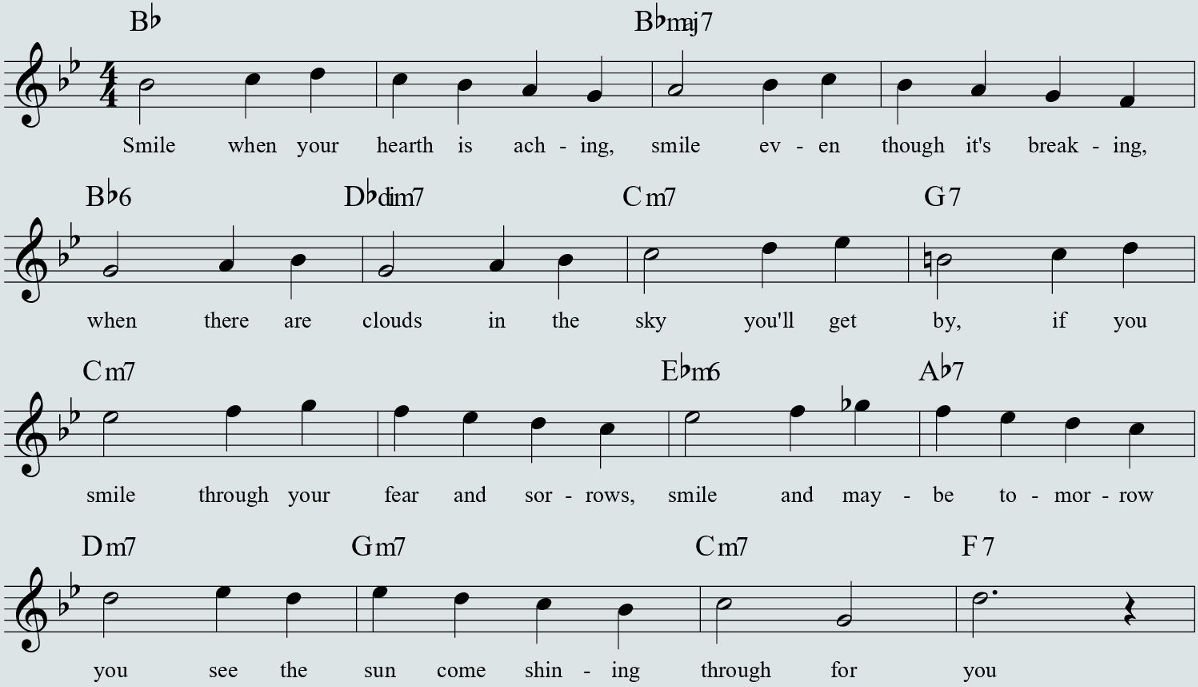[Monday Notes no. 126] Smile, the song written by Charlie Chaplin for his film Modern Times, is more difficult to sing than it may seem. The difficulty, however, is not technical, but in interpretation. Let us therefore see how Judy Garland overcame these difficulties, producing a truly memorable interpretation of Smile.
The melody of Smile is repetitive and always moves on adjacent notes, with movement by joint degrees. The theme is static, somewhat monotonous, and is essentially based on only two rhythmic cells. The first is composed of a minim figure and six quarter notes, like this.

The second rhythmic cell is very similar and alternates a minim and two quarter notes.

The piece is therefore very repetitive, moreover it is composed of two sections of 16 almost identical measures. Smile is the only case I know of a ballad that entered the jazz standards repertoire being harmonically so simple. Let us look at the score of the first part.

As already mentioned, the melody is rhythmically uniform, lacking in surprises. Of course, the singer can always interpret the theme a little in his or her own way, but in this case the source material is certainly uninspiring.
Yet Judy Garland manages to turn Smile into a magnificent song. How does she do it? The singer works on three aspects in particular: lyrics, dynamics, emotion. Let us try to analyse these three elements.
1) The lyrics
The lyrics of Smile were not written by Charlie Chaplin but by John Turner and Geoffrey Parsons, in 1954. The protagonist of the song strives to smile, trying to convince himself that it is the best thing to do despite the fact that his heart is in pain, plagued by sadness and fear.
Judy Garland turns the words of the song into a sincere and moving narration. Every singer should also be a bit of an actor, but this comes particularly naturally to her.
The music is at the service of the lyrics and Judy Garland seems to speak for herself. Indeed, the singer had many reasons to identify with this text, and perhaps it helped her to interpret it in such an intense and emotional way.
2) Dynamics
Judy Garland’s interpretation is based on a careful control of dynamics. The piece starts very quietly and increases little by little. We can realise this if we observe the singer’s mouth and how it opens a little more and more, until the point of peak intensity, also emotional, at minute 2’40”.
The arrangement also contributes to the development of the piece, in fact at minute 2’08” there is a sudden modulation from the initial key of B flat to that of D. The jump in register helps Judy Garland to better express her vocal qualities.

3) L’emozione
The lyrics written by Parsons-Turner greatly enhance Charlie Chaplin’s theme. It is in fact perfect for an indecisive melody, ascending and descending without knowing where to go. Just like those who are torn between discouragement and the desire to carry on, between despair and hope.
Judy Garland lived a troubled existence, giving the world the splendour of her art and keeping the miseries of her private life to herself. Her spell is just that: while singing a song, Judy always seems to be talking about herself and telling her own story.
Listening and watching Judy Garland we get lost in that somewhat bitter and somewhat proud look, her voice singing Smile makes us dream and pulls a tender smile, ‘If you just smile’. Little does it matter if that smile is an illusion.
Until next Monday!
Download teh lead sheet of Smile


